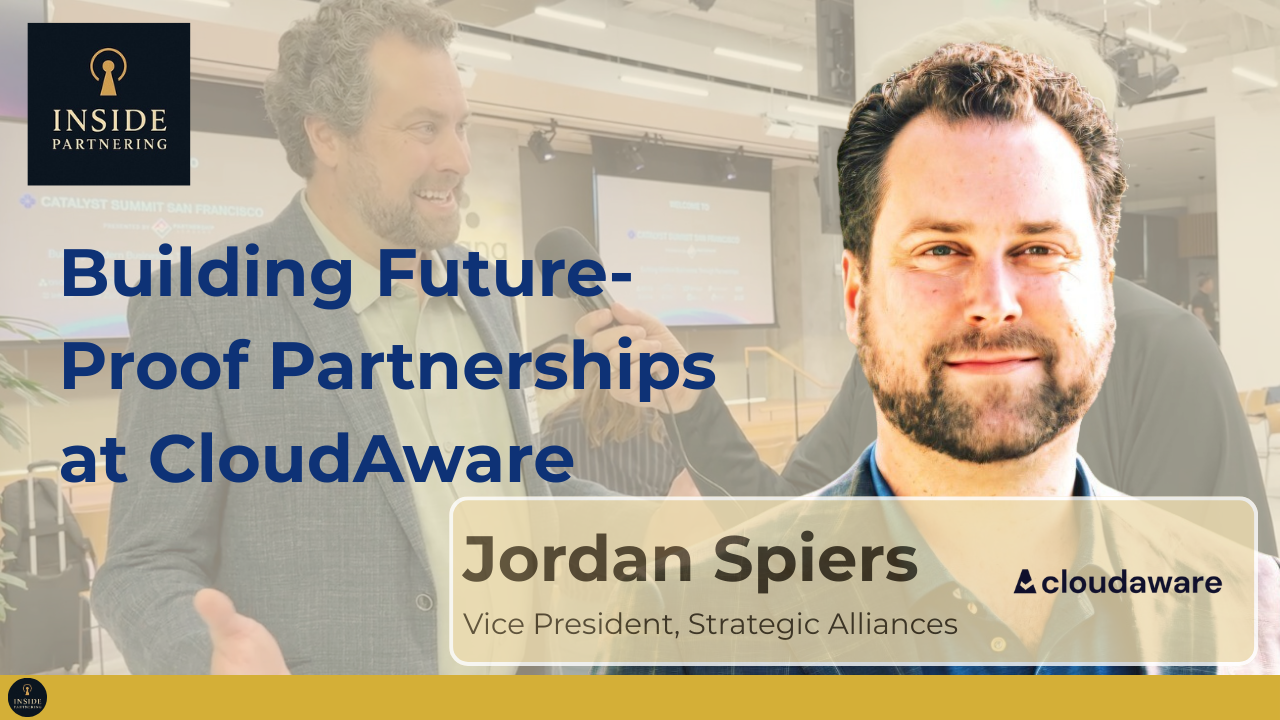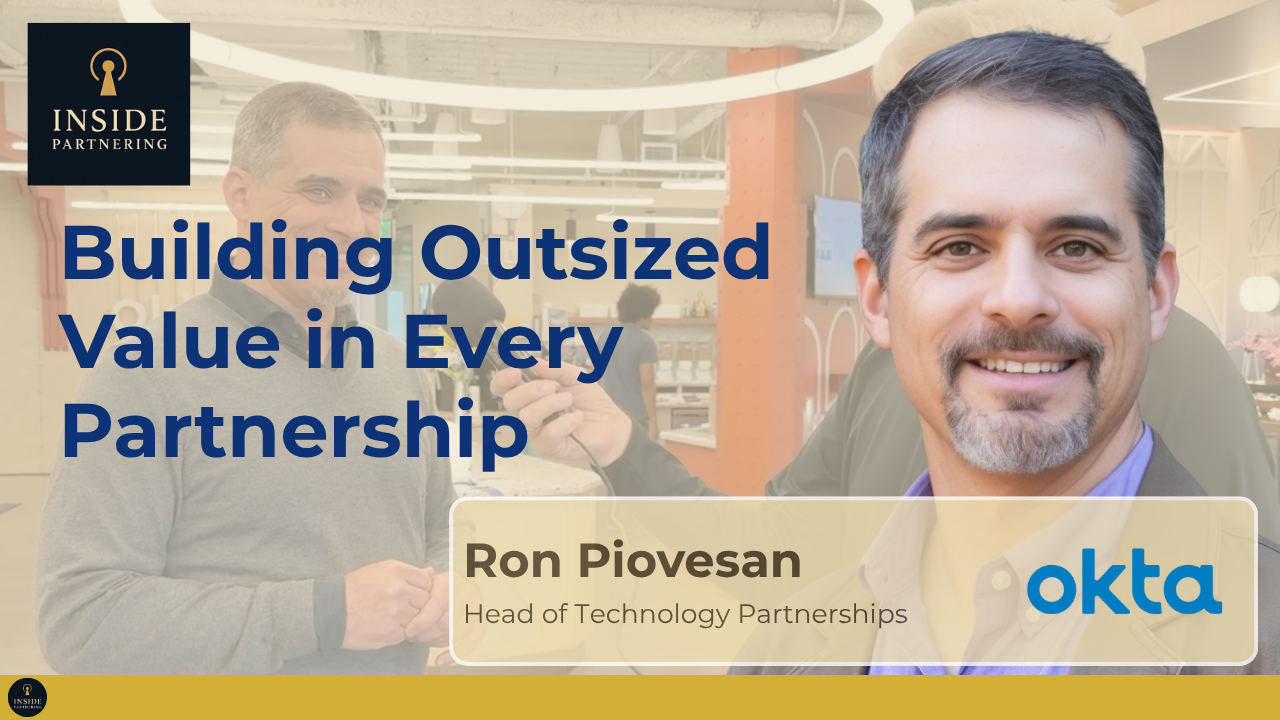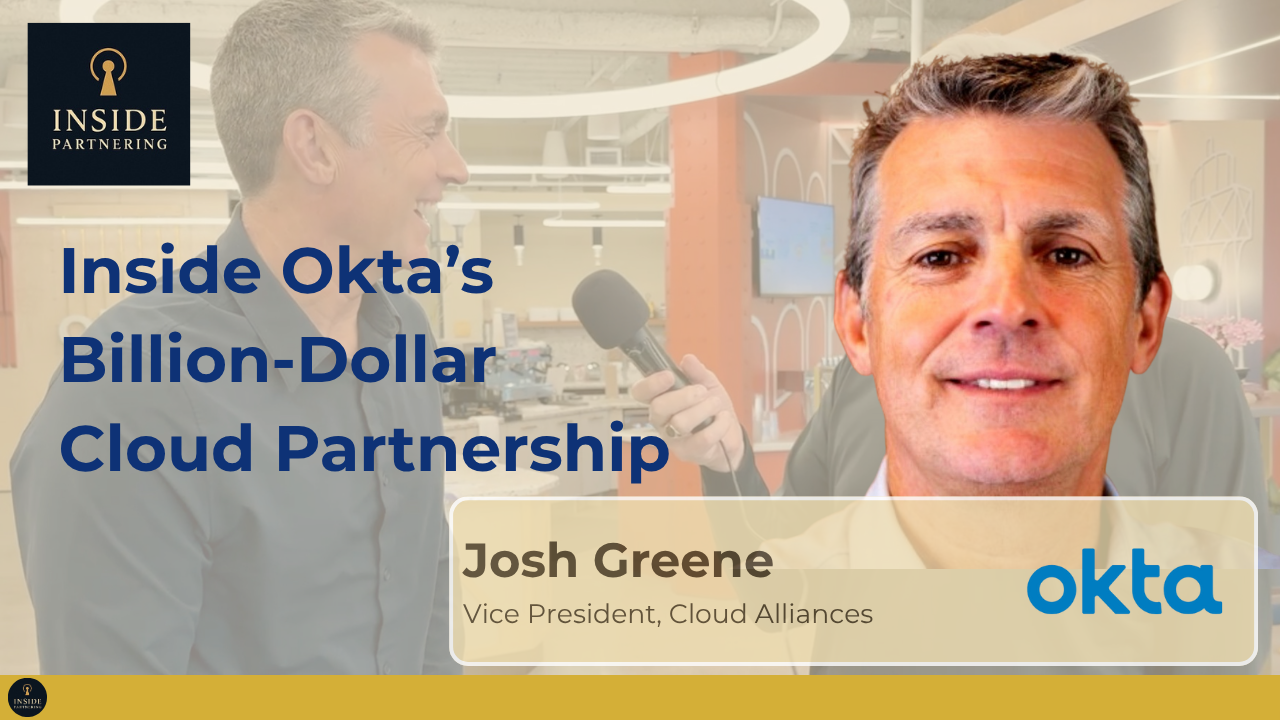Episode Overview
At the Partnership Leaders Catalyst event in San Francisco earlier this month, I had the chance to chat with Jordan Spiers, Vice President of Strategic Alliances at CloudAware. With a career spanning roles at Vonage, New Relic, and IBM’s Bluewolf, Jordan has built a reputation as someone who understands how to take partnerships from reactive to truly strategic.
In our conversation, Jordan shared how CloudAware is helping large enterprises - often spending $50M to $100M+ annually on cloud infrastructure - manage multi-cloud environments with a “single pane of glass” platform. But what stood out most was his philosophy for building partnerships that last.
From Reactive to Proactive
When Jordan joined CloudAware, many of the company’s partnerships had grown opportunistically. If a customer needed an integration, the team would build it, sometimes without thinking about broader opportunities.
Jordan has flipped that script. His team now takes a proactive approach: analyzing customer data, identifying future use cases, and developing partnerships that anticipate where the market is headed.
“It’s about creating future-proof partnerships,” Jordan explained. “We want to understand the arc of where our customers are going and build for that - not just today’s needs.”
Co-Build, Co-Market, Co-Sell
One of the frameworks Jordan uses to organize his team is simple but powerful: co-build, co-market, co-sell. Each partnership motion needs technical collaboration, marketing alignment, and sales execution. By breaking down responsibilities this way, CloudAware ensures that joint solutions aren’t just built - they’re adopted, marketed, and sold in the field.
This clarity also helps with measurement. While the ultimate goal is revenue, Jordan is quick to note the value of tracking KPIs across each pillar - from number of joint solutions developed, to campaigns launched, to pipeline influenced.
Success Stories with AWS and Beyond
Jordan shared that AWS has been a particularly strong partner, especially when it comes to collaborating with services and solutions teams. Together, they’ve built proof-of-concepts for customers that blend CloudAware’s governance platform with AWS native services - sometimes even pulling in other ISVs or SIs to create tri-party solutions.
“It’s not just about driving AWS consumption,” Jordan said. “It’s about solving specific technical use cases that matter to customers.”
What impressed me is how Jordan keeps multiple hyperscaler partnerships in balance. CloudAware works with AWS, Azure, GCP, and others, but Jordan likens his approach to “playing Switzerland.” Rather than favoring one provider, the focus is on giving customers choice and meeting them where they are.
The Power of Clear Goals
Jordan began our conversation with advice that applies to any partnership leader: always write down your goals and KPIs - for your team and your partner’s team. They don’t have to be identical, but they must be explicit. Without shared understanding, misalignment is inevitable.
As Jordan put it: “I’ve made the mistake of assuming alignment before, and it doesn’t work. You have to map out roles, goals, and responsibilities across both sides.”
Final Thoughts
Jordan Spiers offers a great reminder that partnerships succeed when they are intentional, measured, and built with the customer at the center.
Whether through proactive planning, the co-build/co-market/co-sell framework, or balancing hyperscaler politics, his approach is grounded in clarity and collaboration.
For anyone leading alliances in today’s ecosystem-driven world, Jordan’s story offers both inspiration and a practical playbook.
Podcast
Guest

Jordan Spiers
With a proven track record of driving revenue growth and building successful alliances, I am passionate about creating strategic partnerships that deliver exceptional results. As n executive within in the technology industry, I have led global alliances and developed end-to-end cloud strategies with major players such as AWS, Microsoft, Salesforce, ServiceNow and Google. My guiding principle is to always prioritize the business objectives, ensuring that human capital goals are aligned with the overall strategy.
Episode Transcript
[00:00:00] Jordan Spiers: My suggestion is if you don't already do that, make sure you, whether you are starting a new partnership, you have an existing partnership, you have a Best Friends Forever partnership, have those KPIs, have those goals written down for your team, for their team.
[00:00:16] Jordan Spiers: They don't necessarily have to be the same. But make sure that they're, that everybody knows what they're marching towards.
[00:00:26] Chip Rodgers: Hey everyone, Chip Rodgers. We are here back again for another episode of Inside Partnering and we're here actually at Asana headquarters, at the Partnership Leaders Catalyst Summit in San Francisco. And really excited to be joined by Jordan Spiers. Jordan. Jordan, welcome.
[00:00:44] Jordan Spiers: Thank you. Thank you for having me.
[00:00:45] Jordan Spiers: Exciting to be here. A lot of great people here.
[00:00:48] Chip Rodgers: Yeah, it's just starting to get, get together and people are starting to come together. And it's, I think they're gonna be about 200 people here today, awesome. It's terrific. Yeah. Yeah. Good. So Jordan [00:01:00] Spires is Vice President of Strategic Alliances for CloudAware running all the partner organization.
[00:01:07] Chip Rodgers: And you're, you've had a long history in partnerships with IBM and, oh my gosh, no. Vonage. Yeah, Vonage. That's right. Yeah. Vonage, New Relic. New Relic, of course. Yeah. Yeah. Yeah. And I think, we were talking a little bit beforehand. You started actually in partner marketing and your formal role, but then really moved into partnering.
[00:01:26] Chip Rodgers: So that, that's an interesting part of your journey. I'd like to hear about that. Why don't we start first though, with CloudAware and what what you guys and at you and your team are up to at CloudAware.
[00:01:37] Jordan Spiers: Great. Yeah, no, thanks again for having us here. Yeah so CloudAware is a enterprise cloud management platform.
[00:01:43] Jordan Spiers: We typically have customers that are spending 50, a hundred million dollars plus on their cloud infrastructure, have some sort of multi-cloud complex. Infrastructure that we're able to provide that single pane of glass for CCOE [00:02:00] teams, cloud management teams. And we work very closely with quite a few different partnerships, whether they're the hyperscalers with different ISVs, with sis being able to manage, being able to optimize and being able to, whether it's migrate or modernize those architectures for those teams right there.
[00:02:18] Jordan Spiers: And so I oversee our, all of those partnerships. With our team and looking to for more growth opportunities across the board. Yeah. Yeah.
[00:02:28] Chip Rodgers: That's so you're, you've got a lot of with the technology partners, where do they fit? How are, how do they, what kinds of technologies are plugging in that you're then going to market together with?
[00:02:39] Jordan Spiers: Yeah, so there's a lot of capabilities that CloudAware is able to do that we're able to add in our do within our platform. But there are a lot of capabilities that we either don't want to do, or we know other partners do it way better than us. And so we work with a lot of different partners, whether they're in security, observability, governance, or even [00:03:00] some of the native services, working with some of the hyperscalers that we partner with in order to create these joint solutions, co build these solutions that then we can deploy and that can really drive value for our customers.
[00:03:12] Jordan Spiers: So that's typically how we work with a lot of these other tech partnerships. This can be this, we have partnerships with CrowdStrike. We have partnerships with New Relic, with with plenty of other security teams, PagerDuty, Salesforce, ServiceNow and like I said, the hyperscalers as well.
[00:03:30] Chip Rodgers: So where did those come from? What was the sort of generation of those? Did it come from just looking at your customer base, install base or, customer requests or from the product teams or trying to go after new markets or,
[00:03:45] Jordan Spiers: Yeah, so it's actually, it's a good question. Fast forwarding a couple years ago, before I started at this role the partnership strategy with CloudAware was very reactive.
[00:03:54] Jordan Spiers: It was very, we had a customer that needed a particular use case or needed an [00:04:00] integration or needed some sort of API into. Azure, let's say, and they just went out and contacted them and built it right or created that partnership with the ISV and just did it. Where my team comes in is being a little bit more proactive of let's understand where's those, where are those use cases that we can really drive growth, right?
[00:04:20] Jordan Spiers: What are some of the low hanging fruits that we can really go after, and what are some of those long bets that we can really see of creating those joint those, the the joint value prop propositions, the joint technologies that we can go at and really create a differentiated product. That's great. I
[00:04:36] Chip Rodgers: love that.
[00:04:37] Jordan Spiers: And so that's really where my team comes in, is that we think of that proactive approach, right? What, we look at our customer data, we see, what are they using now, what are the needs now? But also where as we're trying to grow our our use cases and trying to optimize the customer's.
[00:04:53] Jordan Spiers: Infrastructure. We really want to think the long term. Where do we see that arc going, that we can really develop [00:05:00] those future proof partnerships for our customers.
[00:05:04] Chip Rodgers: So that's really interesting. So in that case then, when you're, coming up with these ideas, this, strategic approaches to bring new technology partners in to the fold.
[00:05:16] Chip Rodgers: That's a strategic . question. That's a question for CloudAware overall. So I assume, tell me that you're gotta be working with the product teams and understanding, what their roadmap is and how does that whole relationship talk a little bit about that relationship and how that works.
[00:05:34] Jordan Spiers: That's a good question, and I think it's important as you're developing out these joint solutions, I think one of the, one of the reasons I love working in partnership. Also can keep me up at night, but it's sometimes all the different stakeholders you have to deal with on not only your team, but also the partner's team as well.
[00:05:50] Jordan Spiers: And then you have the customer's team as well. And so being able to really map those out, who does what is their role, what are their goals? 'cause a lot of times their goals aren't gonna map to [00:06:00] my team's goals or our counterparts goals. And being able to have that kind of relationship of having that mapped out right there.
[00:06:06] Jordan Spiers: So there's just some holistic thinking around partnerships in general.
[00:06:10] Chip Rodgers: That's critical though, and you're exactly right. It's, there's so many people, not just within the company but the partner teams as well.
[00:06:16] Jordan Spiers: Totally. And
[00:06:17] Jordan Spiers: And that we're all working towards these goals collectively. 'cause I've made that mistake many times over. And it's it doesn't work. Put it that way. Yeah.
[00:06:28] Chip Rodgers: So talk about 'cause this is a relatively new initiative. Without, you don't need to name names but any sort of success stories or things that have really. Panned out like you wanted, that have, that you're nurturing and taking to market?
[00:06:44] Jordan Spiers: Yeah, we have plenty of success stories. I think it's been really exciting getting in front of many different teams.
[00:06:50] Jordan Spiers: I'll call out a WSI think as one particular partner of ours that has been great with. Getting some of their services teams to understand the value [00:07:00] of where our company comes in, how we can be working with some of their native services. And it's not necessarily just about driving AWS consumption or migrating new customers over.
[00:07:11] Jordan Spiers: Yeah, sure we have those kind of use cases we can bring in, but it's really those specific technical use cases that we work specifically with their services teams, with their solution architects teams. Where we could develop these joint where we can identify customers, build out these POCs, and then they take them out to market.
[00:07:30] Jordan Spiers: And it's a really cool just rhythm that they're pulling from with us right now. Oops. Sorry if I'm pulling out of the way here yeah, there we go. But yeah
[00:07:37] Chip Rodgers: The, and you're bringing those use cases with. With AWS.
[00:07:42] Jordan Spiers: Yeah. And sometimes we bring in other ISVs as well or third party or SIs consulting teams as well, create those tri-party solutions that
[00:07:51] Chip Rodgers: Oh, I love that.
[00:07:52] Jordan Spiers: Yeah. Those are great.
[00:07:55] Chip Rodgers: Tell me, talk about the how you're working with, 'cause you're working with the three big cloud [00:08:00] providers, plus others as well. Alibaba, Oracle, I think you've mentioned. And, how does that, how do those relationships work? Because you're both providing techno, you're providing technology for your joint customers, but also they, it has to work really well with each of the cloud providers.
[00:08:20] Jordan Spiers: Yeah, and I really think that's the it's a good point, and I kind I'm waiting for the day when all of a sudden I'm gonna create some sort of. Internal civil war amongst all these partners, but it hasn't happened yet. We've created our swim lanes. We know who went to work with different ones.
[00:08:36] Jordan Spiers: It comes down to what the customer wants, right? The customers usually very particular. We're on AWS on Azure, GCP, whoever, or they have their multi-cloud infrastructure that they want. We play Switzerland in that, right? We're not telling them, oh, you need to migrate to this or migrate to that. We develop the solutions.
[00:08:54] Jordan Spiers: And we'll bring in other partners to develop to, to solve some of their pain [00:09:00] points working with these partners. Therefore, so that's, that, that's how we work with them. Everyone's been very open, very helpful. And it's been an interesting experience getting to work with all of them.
[00:09:10] Jordan Spiers: Yeah.
[00:09:11] Chip Rodgers: I think that's a good way to to, to think about it and to cut the politics out of it, right? It's about what the customer wants.
[00:09:17] Jordan Spiers: Exactly. Yeah. It's, it really comes down to that they'll from, I'm not gonna say they, from time to time, they may ask us for suggestions or some consulting, services that we may be able to provide on one, one particular use case or solution.
[00:09:31] Jordan Spiers: But it really, when it comes down to their cloud infrastructure, we're there to manage it across the board for them and to give them that single pane of glass.
[00:09:40] Chip Rodgers: Let's talk a little bit about about in goals. I know, partnerships, the goal is always revenue. Yep. How do you think about that?
[00:09:49] Chip Rodgers: If it's, or, sourced, influenced but then also some of the other related measurements and activities that that you're looking at. To make sure you're successful. [00:10:00]
[00:10:01] Jordan Spiers: Yeah, there's a lot of ways you could slice that. And I don't think there's really one way that is right.
[00:10:07] Jordan Spiers: There's probably many ways that are wrong. The way I always, in my mind, I think when it comes to partnerships, coil, co-market, co-sell, I think are very three distinctive buckets that, that a team can. Be very good at in those areas. Obviously people can be good at multiple of those, but having that technical product team that can co build a solution.
[00:10:32] Jordan Spiers: You have your marketing team, your partner marketing teams that can create the messaging, create the content, and take it out to market, and then you'll have the partner sales teams. I think our kind of ways that I like to think about organizing a team and those resources needed, obviously then you can break it down by types of partners.
[00:10:51] Jordan Spiers: Channel alliances, all that kind of stuff. But I think that co build, co-market, co-sell is the first way I like to slice and dice [00:11:00] roles within a team. Yeah.
[00:11:02] Chip Rodgers: And are you looking for goals within each of those areas? Yeah. And
[00:11:10] Jordan Spiers: Yeah. Yeah, sure. You can certainly create, there's the overarching KPIs, right?
[00:11:15] Jordan Spiers: Which you've talked about, right? Sourced influenced all that kind of stuff. We could talk about just overarching brand recognition within a hyperscaler ecosystem or a large ISV ecosystem or so forth. But within those you can obviously develop individual KPIs, whether those are in the co build, set, joint solutions, developed adapted solutions by customers marketed, you can all the marketing KPIs and sales, sales KPIs, you can tie to those.
[00:11:43] Jordan Spiers: As well. But overall, you should all be looking, going towards those holistic goals. What's the number in the end? Yeah.
[00:11:51] Chip Rodgers: That's great. Jordan, this has been fantastic. I really appreciate you taking some time and sharing what's happening with CloudAware and bringing some of your [00:12:00] long history in partnerships to to the, your current role and sharing them with us.
[00:12:05] Jordan Spiers: Great. Thank you so much. It was great talking with you. Let's do it again. Likewise. Terrific. Alright.
[00:12:10] Chip Rodgers: And thank you all again for for joining and we'll see you. See you next time. Thanks everybody.

Chip Rodgers
🚀 CMO | Chief Partner Officer | B2B SaaS Growth & GTM Leader | Ecosystem Strategy | Demand Gen | Podcast Host 🎙




